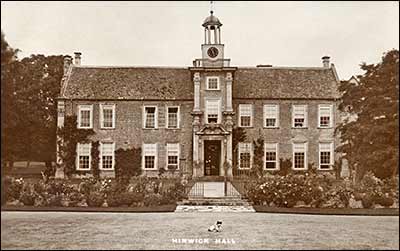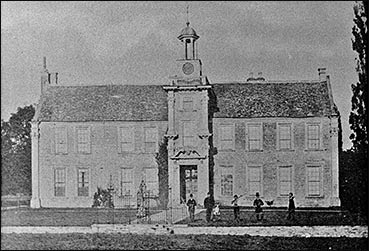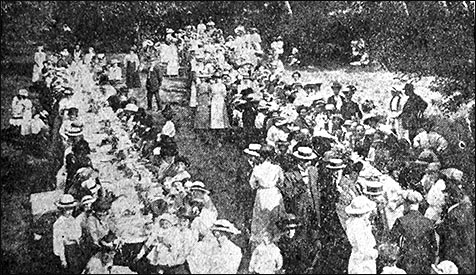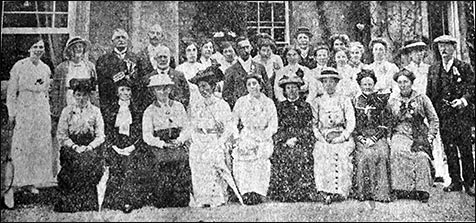| Ice Houses - At Hinwick Lodge, in the parish of Podington, there was an ice house that was still in use in the 1920s. My grandmother farmed this farm during this period and my father cut the ice (using a cross cut timber saw) from Plain Pond and Neats Pond during severe winter conditions and stacked it among a packing of straw for use during the summer to keep fish and meat fresh. I rather think it has now disappeared; it was constructed under ground in the vicinity of Great Hayes Wood.
Ann Cooper, July 2004, Editor of Higham Chichele Society "Bygone Times"
Extracted from her own memories "Tales my father told me".
|
| The "Slade" at Hinwick was planted in 1842 by Richard Longuet Orlebar (1806-1870). He had succeeded to the Hinwick estate on the death of his father in 1833.
He was able to do this owing to the generosity of two peopl, his cousin William Augustus Orlebar of Hinwick Hall and Lord St John of Bletsoe. William gave him lime tree saplings and lord St John gave him elm saplings. These trees were planted alternately and it was decided to see which thrived the best and to keep those as the "Avenue". In the event it was the lime trees that made the best progress, consquently they were kept and are still there today.
Ann Cooper, August 2004, Editor of Higham Chichele Society "Bygone Times"
|
Rushden Argus, 3rd July 1914
Al Fresco Politics
Huge Primrose League Gathering at Hinwick House
Photos by Chapman
below: At the tea tables - which were seated amid the grateful shade of the trees
|
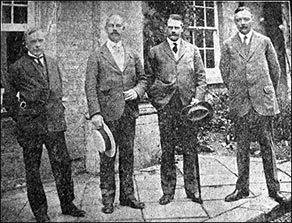 |
|
Speakers - l-r: Mr W A S Hewens, MP (Hereford), Mr R Orlebar, JP, Col Glyn, DCO & Capt Maunsell
|
|
|
|
|
|
|
A group of Primrose League workers
|
|
Rushden Echo, 15th October 1909, transcribed by Peter Brown
Cubs Killed Near Irchester – The Oakley hounds met at Hinwick on Tuesday morning, and proceeded to Knuston, two cubs being found near the railway not far from Irchester station. One cub started across the field, but suddenly ran back into the covert from whence it once more emerged, only to run back again. Before it could regain the covert, hounds got hold of it and killed it. Meantime the second cub got away into some bushes, and here, after killing the first cub, the hounds soon found it. The cub ran into the brook, where it turned on one of the hounds, but it was soon overpowered by the pack and killed in the middle of the stream. Hounds then left for Wollaston Park. There was a fairly good company out.
|
Rushden Echo, 10th November 1911, transcribed by Kay Collins
Hinwick – An Awkward Predicament—Mr. Clayson, of Harrold, who was driving on Sunday afternoon last to Irchester to conduct services at the Baptist Chapel there had an unpleasant experience between Hinwick and Farndish. The gale had blown down a tree, which lay right across the road, so that the trap could not get past. There was no time for Mr. Clayson to drive to Irchester by way of Wymington and Rushden, so he sent his companion with the trap via Rushden while he himself walked to Irchester across country. Meanwhile word was sent to the Podington policeman, who took steps to have the tree removed.
|
Rushden Echo, 19th July 1918, transcribed by Kay Collins
Hinwick - Flax—At the meeting of the Higham and Rushden Water Board on Monday the Surveyor (Mr. W. Madin) reported: “Since the last meeting of the Board we have made a connection off the pumping main in Podington parish to supply the camp of flax pickers on the Hinwick estate. The Board’s men were assisted by the Royal Engineers, who laid the mains, fixed the tanks, etc. There is a good supply available, but, owing to the limited storage capacity, it will probably be necessary to pump for a little while each Sunday”. A large number of girls arrived early this week. Arrangements are being made locally to provide the flax pickers with amusements.
|
Rushden Echo, 28th June 1923, transcribed by Kay Collins
A Garden Fete was held in the grounds of Hinwick Hall, on Saturday last, in aid of the Nursing Association. Large numbers of visitors came from near and far. A tennis tournament, several concerts, and many side-shows were provided. The function was a huge success.
|
Rushden Echo, September 7th 1923, transcribed by Kay Collins
The Oldest Inhabitant—A few days ago Mr. Draper, of Hinwick, celebrated his 92nd birthday. He is the oldest inhabitant in Podington and Hinwick, and he still enjoys good health.
|
|
Rushden Echo & Argus, 8th January 1932, transcribed by Kay Collins
A Schneider Trophy Sensation
It was revealed this week that during the practices for the Schneider Trophy contest a critical experience befell the chief of the High Speed Flight, Wing Commander A H Orlebar (who, of course, has associations with Hinwick Hall).
One of the 1929 Schneider Trophy seaplanes, an S6A, to which new and bigger floats had been fitted to hold the greater quantity of fuel needed, was taken up by Squadron-Leader Orlebar for the first test.
Suddenly the tail of the seaplane began to “flutter”. This is a violent and very rapid oscillation which, reacting on the pilot’s controls cannot be stopped.
Even on an ordinary slow aeroplane undergoing preliminary type tests it is a terrifying experience, for the controls tend to master the pilot.
The controls break, and the machine falls out of control, with inevitably fatal results, save for a parachute, an accessory not carried in Schneider Trophy seaplanes.
Squadron-Leader Orlebar landed at the mouth of Beaulieu River. Calshot saw it closely, and on the instant fast motor-boats were despatched in the almost vain hope of being of service.
|
|
Rushden Echo, 24th Mar 1944, transcribed by Kay Collins
Podington’s First “International”
American Air Sergeant Weds English Girl
The wedding between Sergt. Joe G Skarzynski, of the U.S.A.A.F. and Miss Lillian Taylor, of Southport, which took place at Podington last Saturday, was the first Anglo-American marriage to be held there, and was conducted in the Parish Church by the Rev. V. J. H. Coles.
The bride is the second daughter of Mrs. H. Taylor, of 10 Banastre-road, Southport, Lancs., and the groom is the eldest son of Mr. Joseph V. Skarzynski, of 2313 W Mitchell-street, Milwaukee, Wisc., U.S.A.
Attired in a blue costume with wine coloured accessories and carrying a bouquet of white carnations and fern, the bride was given away by Mr. James Albert Roberts. In attendance were Miss Evelyn Joyce Bowers and Miss Rebecca Taylor, of Southport. Both wore dresses of a London tan shade and had corsages of orchids.
Ed. Ellington, U.S.A.A.F., of Lorin Blanchard, carried out the duties of best man.
A reception followed at Hinwick Lodge, and the wedding cake was a gift of the U.S.A.A.F. For the journey to Southport, where the honeymoon was spent, the bride was wearing a grey ensemble.
|
|
